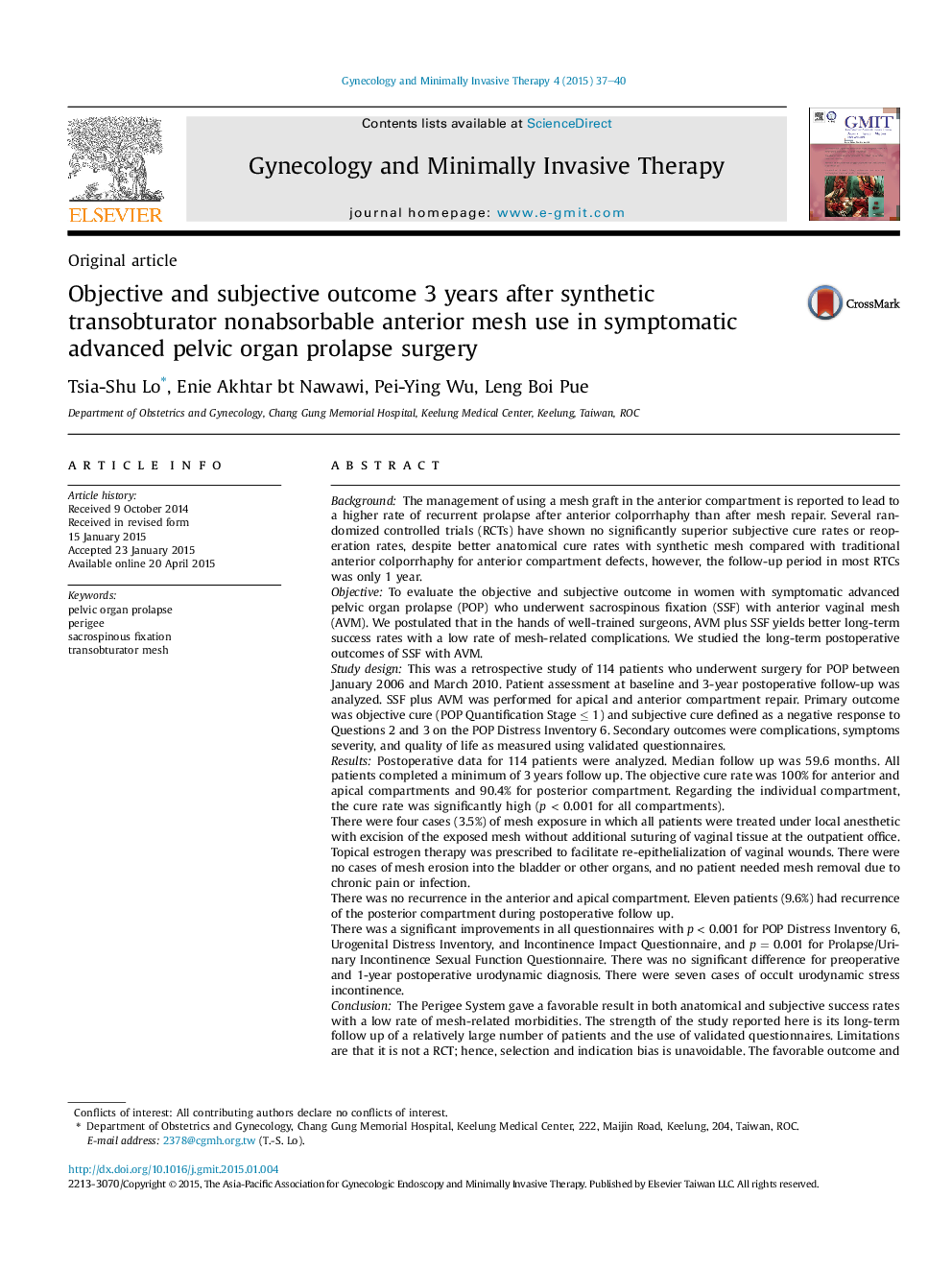| Article ID | Journal | Published Year | Pages | File Type |
|---|---|---|---|---|
| 3953717 | Gynecology and Minimally Invasive Therapy | 2015 | 4 Pages |
BackgroundThe management of using a mesh graft in the anterior compartment is reported to lead to a higher rate of recurrent prolapse after anterior colporrhaphy than after mesh repair. Several randomized controlled trials (RCTs) have shown no significantly superior subjective cure rates or reoperation rates, despite better anatomical cure rates with synthetic mesh compared with traditional anterior colporrhaphy for anterior compartment defects, however, the follow-up period in most RTCs was only 1 year.ObjectiveTo evaluate the objective and subjective outcome in women with symptomatic advanced pelvic organ prolapse (POP) who underwent sacrospinous fixation (SSF) with anterior vaginal mesh (AVM). We postulated that in the hands of well-trained surgeons, AVM plus SSF yields better long-term success rates with a low rate of mesh-related complications. We studied the long-term postoperative outcomes of SSF with AVM.Study designThis was a retrospective study of 114 patients who underwent surgery for POP between January 2006 and March 2010. Patient assessment at baseline and 3-year postoperative follow-up was analyzed. SSF plus AVM was performed for apical and anterior compartment repair. Primary outcome was objective cure (POP Quantification Stage ≤ 1) and subjective cure defined as a negative response to Questions 2 and 3 on the POP Distress Inventory 6. Secondary outcomes were complications, symptoms severity, and quality of life as measured using validated questionnaires.ResultsPostoperative data for 114 patients were analyzed. Median follow up was 59.6 months. All patients completed a minimum of 3 years follow up. The objective cure rate was 100% for anterior and apical compartments and 90.4% for posterior compartment. Regarding the individual compartment, the cure rate was significantly high (p < 0.001 for all compartments).There were four cases (3.5%) of mesh exposure in which all patients were treated under local anesthetic with excision of the exposed mesh without additional suturing of vaginal tissue at the outpatient office. Topical estrogen therapy was prescribed to facilitate re-epithelialization of vaginal wounds. There were no cases of mesh erosion into the bladder or other organs, and no patient needed mesh removal due to chronic pain or infection.There was no recurrence in the anterior and apical compartment. Eleven patients (9.6%) had recurrence of the posterior compartment during postoperative follow up.There was a significant improvements in all questionnaires with p < 0.001 for POP Distress Inventory 6, Urogenital Distress Inventory, and Incontinence Impact Questionnaire, and p = 0.001 for Prolapse/Urinary Incontinence Sexual Function Questionnaire. There was no significant difference for preoperative and 1-year postoperative urodynamic diagnosis. There were seven cases of occult urodynamic stress incontinence.ConclusionThe Perigee System gave a favorable result in both anatomical and subjective success rates with a low rate of mesh-related morbidities. The strength of the study reported here is its long-term follow up of a relatively large number of patients and the use of validated questionnaires. Limitations are that it is not a RCT; hence, selection and indication bias is unavoidable. The favorable outcome and low morbidities resulting from mesh use is from a single surgeon's perspective and may not be generalized to others.
